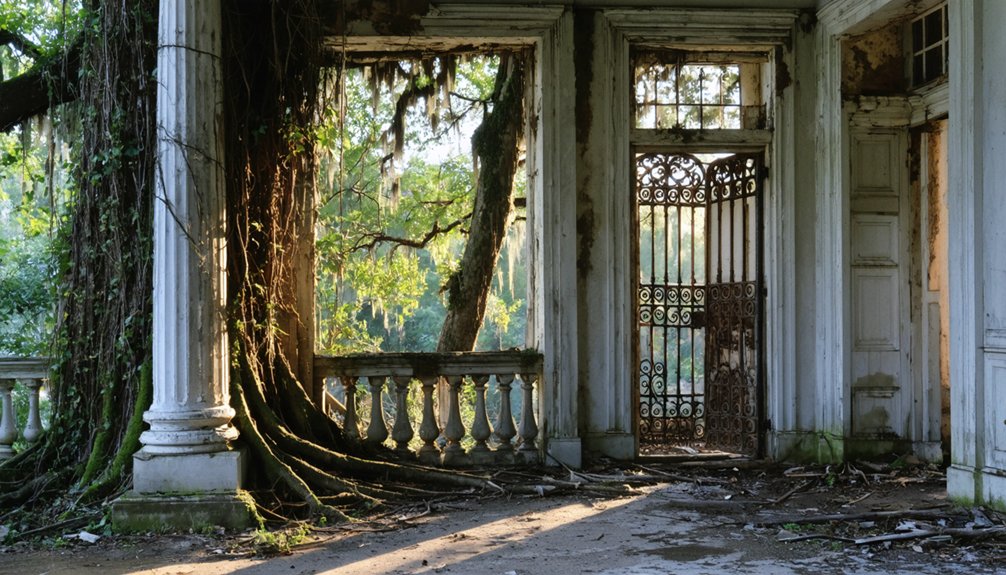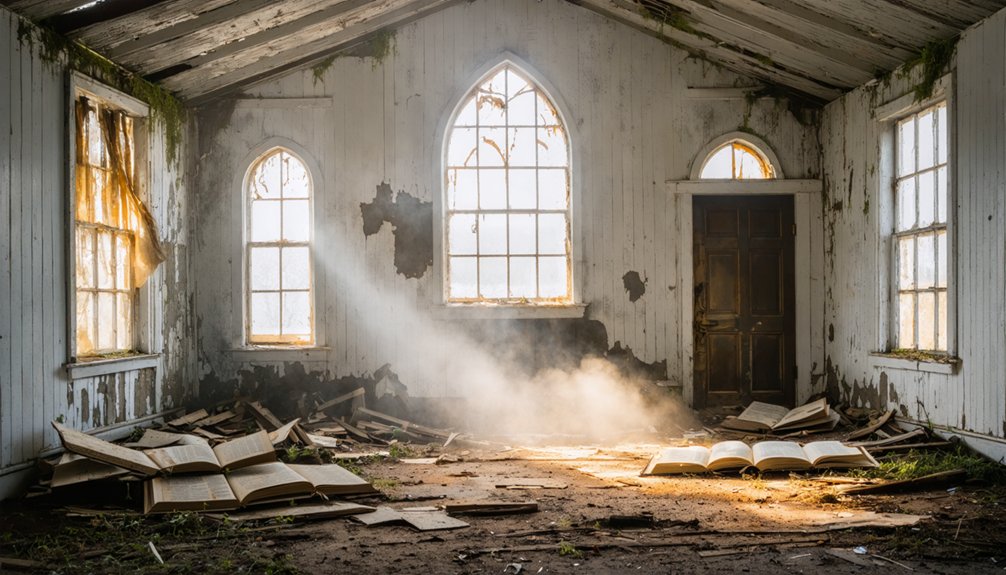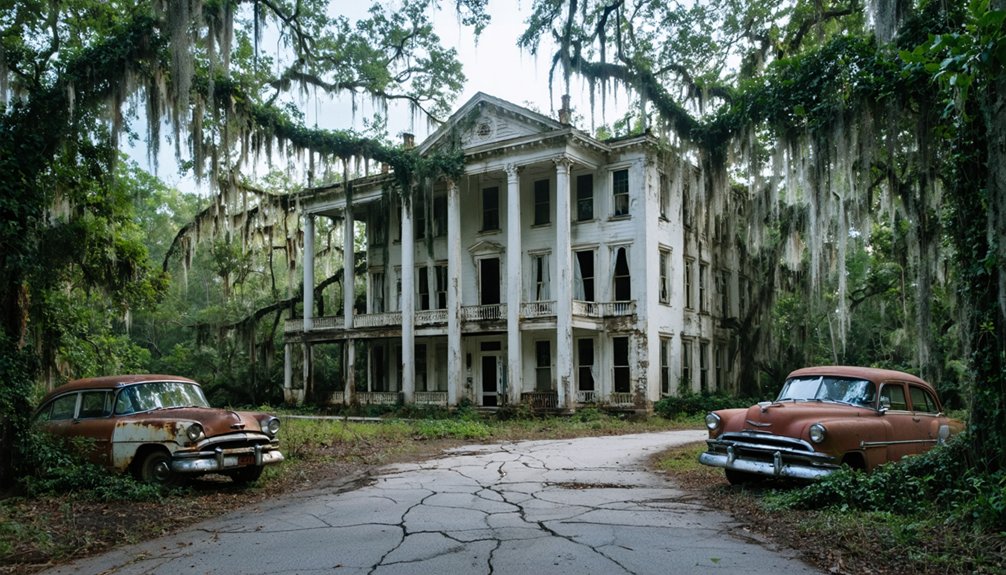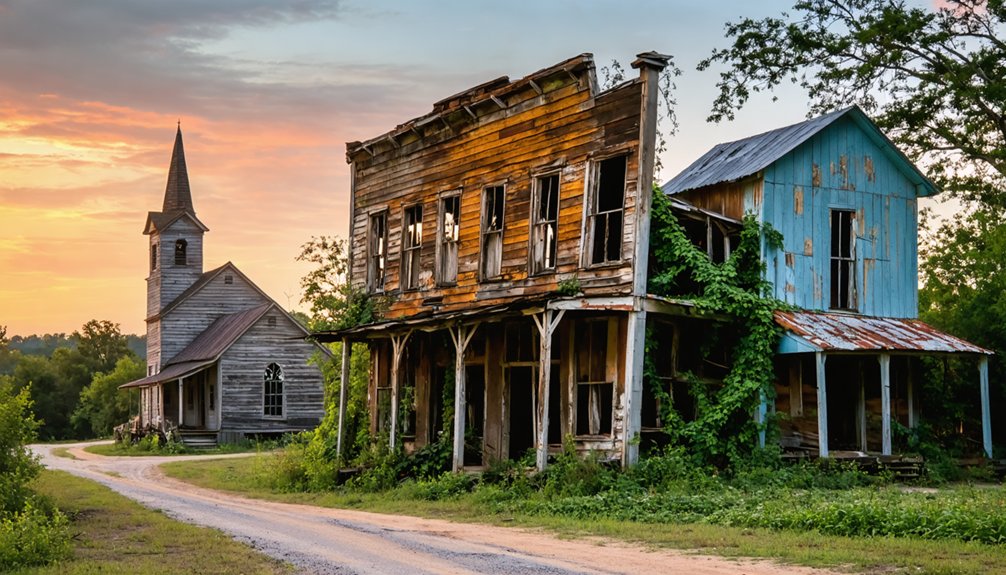Southern ghost towns reveal fascinating secrets including overnight railroad settlement disappearances, underwater communities submerged by reservoir projects, and forgotten “freedom towns” established by formerly enslaved people. You’ll discover abandoned mining boomtowns, settlements decimated by disease, and communities reclaimed by wilderness. These sites preserve industrial archaeology through deteriorating churches, abandoned machinery, and mining structures. The ruins of these once-thriving communities offer powerful insights into the South’s complex economic, social, and cultural history.
Key Takeaways
- Ghost towns like Steins, NM vanished overnight when railroad companies rerouted lines, leaving behind hotels and stores as silent witnesses.
- Freedom towns established by formerly enslaved people between 1865-1930 disappeared due to economic pressures and systematic undocumentation.
- Disease outbreaks transformed thriving settlements into abandoned towns within months, particularly devastating river communities.
- Churches often remain as the last standing structures in ghost towns, serving as powerful symbols of community resilience.
- Nature rapidly reclaims abandoned towns, with buildings dissolving into landscapes and wildlife returning to territories once occupied by humans.
The Hidden Railroad Settlements That Vanished Overnight
While exploring the forgotten landscapes of the American South, you’ll discover that many ghost towns originated as vibrant railroad settlements that materialized and dissolved with remarkable speed.
Places like Steins, New Mexico (1878) and Montoya (1902) emerged strategically alongside key railroad infrastructure—roundhouses, repair shops, and water wells for locomotives.
These settlements supported a transient workforce of railroad employees, miners, and ranchers. You’ll find evidence of their bustling past in remnants of hotels, general stores, and blacksmith shops that once served travelers and workers alike. Steins reached its apex with a population of over 1,000 residents by 1919, showcasing how rapidly these communities could grow.
When rail companies rerouted lines or discontinued service, these towns vanished almost overnight. Without economic diversity, they couldn’t survive when their primary lifeline disappeared, leaving behind only weathered structures as silent witnesses to their brief existence. For proper documentation, these locations should include accurate coordinates to help preserve their historical significance.
Underwater Ghost Towns: Southern Communities Claimed by Reservoir Projects
Beneath the placid surfaces of many Southern reservoirs lie the submerged remains of once-thriving communities, sacrificed in the mid-twentieth century for large-scale water management and hydroelectric projects.
You’ll find towns like Fairdale (Toledo Bend Reservoir), Proctor (Fontana Lake), and Butler (Tennessee Valley) forever silenced by rising waters—their citizens displaced through eminent domain with modest compensation for their lands and homes.
The reservoir repercussions extended beyond mere physical displacement; they fractured generational connections to place. A.A. McGraw received approximately $125 per acre for his family farm that was ultimately submerged by 1969.
Cemetery relocations attempted to preserve some dignity, with authorities meticulously mapping and moving family plots to higher ground. Similar to Sopris, these mining communities along the Purgatoire River were forcibly relocated in the 1970s to mitigate flooding.
However, unmarked or unclaimed graves often remained underwater, their submerged histories accessible only through archaeological excavation or the memories of displaced residents who gather for reunions to commemorate what was lost beneath the artificially calm waters.
Post-Civil War “Freedom Towns” Lost to History
As water claimed some Southern communities in the twentieth century, a different kind of disappearance had already been occurring across the post-Civil War landscape. You might never know that between 1865-1930, hundreds of “freedom towns” emerged as bastions of Black autonomy, established by formerly enslaved people on marginal lands through cash purchases or adverse possession.
These settlements represented profound freedom struggles, creating self-sustaining environments with churches, schools, and cemeteries serving as anchors for cultural preservation. The Texas Freedom Colonies Project has documented 357 Black settlements since 2014 through various research methods.
By 1910, Black land ownership in Texas had risen from 2% to 31%, largely through these communities.
Yet these towns vanished gradually—absorbed by urban sprawl, dismantled by economic pressures, or deliberately erased from maps. Many of these communities were reclaimed by vines and wildlife, similar to the fate of towns destroyed during the Civil War. Their disappearance represents not just physical loss but the systematic undocumentation of African American placemaking and resilience during Reconstruction and Jim Crow.
Secret Mining Boomtowns of the Appalachian South
While you might expect the Appalachian coal towns to mirror western gold rush settlements in their sudden prosperity, these southern boomtowns instead reflected a more controlled industrial expansion where outside northern capitalists established company-owned communities housing over 700,000 miners at their peak.
You’ll still find haunting evidence of this era in the abandoned mine shafts, collapsing wooden supports, and rusting machinery that dot the landscape across Kentucky, West Virginia, and Tennessee.
The boom-bust cycle that created and then destroyed these towns forms a critical chapter in Appalachian history, where the rapid growth fueled by post-Civil War coal demand eventually gave way to economic collapse when mines closed, leaving behind ghost towns that tell stories of both exploitation and resilience. Miners often risked their lives daily for meager wages of 3 to 5 dollars, barely enough to support their families while working in extremely hazardous conditions. Between 1880 and 1930, more than 600 company towns were constructed across the region, with approximately 78% of miners and their families living completely under company control at the height of the coal boom.
Gold Rush Overnight Wealth
Long before California’s famous gold rush captivated the nation, the quiet hills of the Appalachian South witnessed America’s first major gold fever when a remarkable discovery at Reed Farm in North Carolina in 1799 set off a chain of events that would transform the region.
You’d be astonished by the gold rush fortunes that materialized virtually overnight, creating instant wealth that rivaled established industries. The discovery of a 28-pound nugget—then the third largest in world history—triggered economic transformations across the southern Appalachians. Benjamin Parks’ discovery in 1828 while walking in the Appalachian mountains further intensified the gold rush.
Mining community dynamics evolved rapidly as:
- Thousands of prospectors flocked to protected Cherokee territories
- Slave labor was exploited to maximize production during agricultural off-seasons
- Northern investors introduced advanced technologies that revolutionized extraction methods
These rapid developments created an unprecedented economic boom, establishing gold as North Carolina’s second-leading export for decades. Though these southern gold discoveries were significant, they were eventually overshadowed by the Western U.S. findings that produced over 75% of America’s gold through the late 1960s.
Abandoned Mining Equipment Remains
The gold-seeking frenzy that once energized the Southern Appalachians left behind more than just economic impacts—it created a landscape punctuated by the skeletal remains of industrial ambition.
As you explore these forgotten valleys, you’ll encounter abandoned machinery strewn across former boomtowns—hand drills and timber supports from early operations alongside massive mechanized equipment from mid-century mining.
These mining relics occupy precious valley space, with deteriorating coal tipples, coke ovens, and branch railroad tracks forcing housing to scatter haphazardly on mountainsides or along creeks.
Steam engines and sawmills, once essential to operations, now rust silently in forest reclamation.
These postindustrial artifacts carry educational and archaeological value as witnesses to rapid industrialization and subsequent economic collapse, their presence telling stories of labor practices and environmental consequences that continue to shape Appalachian identity.
Appalachian Boom-Bust Cycle
Deep within the hollows and valleys of Southern Appalachia lies a historical pattern that shaped not only the region’s economic trajectory but also its cultural identity—the dramatic boom-bust cycle of mining communities.
You’ll find the boomtown legacy etched across landscapes where once-thriving settlements experienced meteoric rises followed by devastating collapses. Between 1880-1920, over 700,000 miners labored across nearly 12,000 operations, creating vibrant but precarious economies.
The cycle followed predictable phases:
- Rapid expansion when coal deposits were discovered and railroads arrived
- Brief prosperity under the control of coal barons and companies
- Sudden abandonment when resources depleted or markets shifted
This economic vulnerability left communities defenseless against market fluctuations.
When companies departed—taking jobs, housing, and infrastructure—they left behind ghost towns, reclaimed by forests but remembered through oral histories and deteriorating structures.
Ghost Towns Created by Deadly Disease Outbreaks
Disease outbreaks have repeatedly transformed thriving Southern settlements into abandoned ghost towns, often within remarkably short timeframes.
You’ll find epidemic impacts starkly illustrated in places like Hindostan Falls, Indiana, where cholera and yellow fever decimated the population within just four years during the 1820s, killing 138 residents in a mere three months.
The 1918 Spanish Flu devastated communities like Midco, Missouri, where over 1,600 fell ill and dozens died, overwhelming the town’s resources as government gravediggers worked continuously.
Yellow fever’s ghost town origins are evident in the 1878 epidemic that ravaged Memphis, killing 5,000 people while wealthy residents fled, leaving poorer populations to suffer.
River towns proved particularly vulnerable as infected travelers spread disease rapidly, accelerating community collapse and abandonment.
Abandoned Plantation Communities and Their Untold Stories

Hidden beneath overgrown Southern landscapes, abandoned plantation communities represent complex historical narratives that extend far beyond their decaying architectural façades.
These plantation remnants—once numbering over 46,200 across the South—tell stories of economic power built upon enslaved labor and hierarchical social structures. You’ll find that most were operated by absentee landowners, challenging the romanticized image of stately mansion-centered operations.
Beneath Southern soil lies evidence of economic empires built on human bondage, not the nostalgic plantations of collective memory.
- Enslaved people constructed virtually all plantation structures, yet their quarters rarely survived into the 21st century.
- Post-emancipation economic shifts led to widespread abandonment, with once-thriving communities becoming rural ruins.
- Cultural legacies persist through local archives, oral histories, and preserved structures like the Boyette Plantation Slave House.
These forgotten communities hold critical insights into how plantation systems shaped Southern society, influencing racial segregation and social hierarchies long after emancipation.
Towns Swallowed by Southern Wilderness: Nature’s Reclamation
Throughout the American South, countless once-vibrant communities now lie beneath dense canopies of kudzu, pine, and oak, surrendering to nature’s relentless reclamation process.
You’ll find places like Elkmont, Tennessee, where abandoned cabins slowly dissolve into the Great Smoky Mountains, and Terlingua, Texas, where desert sands gradually consume mining remnants.
Nature’s resilience manifests rapidly after abandonment—vegetation breaches walls, wildlife reclaims territories, and waterways shift course.
Economic collapse, transportation changes, and government land acquisitions have all triggered this southern decay. Wooden structures typically vanish within decades, while brick and stone resist longer before surrendering.
Behind these transformations lie human stories preserved through historical societies, archaeological surveys, and community initiatives—final efforts to document settlements before wilderness completely erases evidence of their existence.
The Forgotten Resort Communities of the Southern Mountains

While the grand hotels and bustling cottage communities of the Southern Appalachians once represented the pinnacle of early twentieth-century leisure culture, they now stand as decaying monuments to a forgotten vacation era.
These forgotten resorts emerged from humble logging and mining outposts, transforming into thriving vacation destinations when railroads made mountain retreats accessible to urban dwellers seeking respite.
- The Appalachian Clubhouse in Elkmont and Poconos Manor exemplify the evolution from simple retreats to sophisticated destinations.
- From the 1920s through the 1960s, these communities fostered a distinctive cultural heritage with rustic architecture and seasonal traditions.
- National park expansions, transportation shifts, and economic downturns ultimately led to their abandonment, leaving over 70 structures in Elkmont alone.
Industrial Ghost Towns: When Southern Factories Closed Forever
As you walk through the South’s abandoned textile mill towns, you’ll witness the skeletal remains of once-thriving industrial complexes where thousands of workers once operated massive looms and spinning machinery.
The pattern of decay extends beyond textile manufacturing to countless mining communities, where company stores and worker housing now stand vacant alongside the hollowed-out entrances to depleted coal and mineral deposits.
These industrial ruins represent the devastating economic aftermath when single-industry towns lost their economic engines, transforming vibrant communities into historical artifacts of American manufacturing’s golden age.
Textile Mill Skeletons
The skeletal remains of Southern textile factories stand as silent monuments to a once-thriving industrial era that shaped the region’s economic and social landscape.
These textile relics, primarily constructed along rivers for water power, have witnessed the dramatic rise and fall of communities built entirely around manufacturing.
You’ll find these mill memories preserved in towns like Coleridge, North Carolina, where Victorian-style brick factories with imposing towers still dominate the landscape.
- L-shaped brick factories with wooden worker cottages clustered nearby
- Commercial cores featuring company stores, mill offices, and banks
- Segregated housing arrangements with racial boundaries clearly defined
Mining’s Hollowed Towns
Beyond the textile industry’s remnants lie even more haunting Southern landscapes where mining once ruled supreme.
You’ll find these hollowed towns characterized by abandoned mine shafts, deteriorating coke ovens, and crumbling ore-processing facilities—physical manifestations of once-thriving economic engines.
Mining legacies remain visible in places like Cambria, where anthracite extraction supported communities for decades before depletion triggered their downfall.
When mines closed, catastrophic unemployment followed. Workers fled, businesses shuttered, and community identities fractured. The economic decline wasn’t merely statistical; it represented profound social disruption across the Southern industrial landscape.
Some sites, like Pactola, disappeared entirely—now submerged beneath reservoir waters.
Others, like Castle Dome, transformed from war-supporting mineral producers to silent monuments of industrial archaeology, their environmental scars still visible decades after production ceased.
Sacred Spaces Among the Ruins: Churches That Outlasted Their Towns

Standing tall amid crumbling facades and overgrown streets, churches represent the most enduring physical remnants of Southern ghost towns. Their spires and steeples reach skyward long after the communities they once served have faded into memory.
These structures, defined by their distinctive church architecture, were central to community identity—hosting baptisms, weddings, and funerals before time marched onward.
You’ll notice three consistent patterns in these sacred spaces:
- Robust construction (like St. John’s brick rebuild in Bomarton) enabled physical endurance
- Central positioning as community gathering places preceded their eventual abandonment
- Preservation efforts now struggle against nature’s reclamation (as with Rodney Presbyterian)
These architectural sentinels remind us how spiritual foundations often outlast economic ones, standing as monuments to communities that valued permanence in their sacred spaces.
Frequently Asked Questions
How Do Ghost Towns Affect Property Values in Neighboring Communities?
Ghost towns markedly depress your property market, reducing neighboring values by 2-9%, eroding tax bases, and catalyzing community impact through service cuts, increased crime, and cyclical disinvestment patterns.
Can I Legally Collect Artifacts From Abandoned Southern Ghost Towns?
You can’t legally collect artifacts without proper permissions. On private land, you’ll need landowner consent; on public lands, permits are required. Artifact preservation regulations vary by jurisdiction but are strictly enforced.
Which Southern Ghost Towns Have the Strongest Paranormal Activity Reports?
With 78% of visitors reporting encounters, Cahawba, Alabama tops haunted locations for spectral sightings, followed by Charleston’s historic sites and Louisiana’s Natchez and St. Francisville, where you’ll experience intense paranormal activity.
Are There Undiscovered Ghost Towns Still Waiting to Be Found?
Yes, thousands of ghost towns await your discovery, particularly across the rural South. Urban exploration may reveal hidden treasures where untamed vegetation and erosion have shrouded these settlements from historical documentation.
How Do Descendants of Ghost Town Residents Maintain Connection to These Places?
You’ll find descendants keeping their bygone heritage alive through family reunions, oral histories, cemetery maintenance, genealogical documentation, and historical preservation efforts—all fostering tangible connections to their ancestral communal spaces despite abandonment.
References
- https://openprairie.sdstate.edu/etd/4061/
- https://en.wikipedia.org/wiki/Wikipedia:WikiProject_Ghost_towns
- https://www.mentalfloss.com/geography/wanderlust/creepiest-ghost-towns-united-states
- https://www.youtube.com/watch?v=fPqYTIxEM3w
- https://www.geotab.com/press-release/american-ghost-towns/
- https://m.dresshead.com/files/scholarship/Documents/Ghost_Towns_Lost_Cities_Of_The_Old_West_Shire_Usa.pdf
- https://247wallst.com/special-report/2018/11/02/30-american-ghost-towns-3/
- https://noospheregeologic.com/blog/tag/ghost-towns/
- https://www.geotab.com/ghost-towns/
- https://en.wikipedia.org/wiki/Ghost_town



